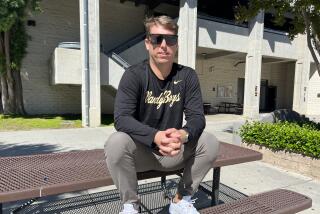Doctor Advised Gathers to Quit Playing : Medical: Loyola Marymount star missed final treadmill test, probably stopped taking medication in final days before death.
- Share via
Hank Gathers, the Loyola Marymount basketball star who died Sunday night, was told not to play after his initial fainting episode, according to a cardiologist familiar with the case.
In addition, in the final days before he died he did not show up for his scheduled weekly treadmill test and is suspected to have not taken his heart medicine. The same cardiologist also said that it wouldn’t have mattered what tests or medical advice were given to Gathers because he was going to play anyway.
“He was told not to play, you’re through as an athlete,” said the cardiologist, who asked not to be identified. “We told Hank that if he wanted to live the best he shouldn’t exercise. Hank Gathers was going to play basketball. It didn’t matter what some doctor told him.
“He was known to have cardiac arrhythmia, no question about it. But it was well treated and well controlled and it had been well tested every time. We don’t know if Hank took his medicine the last week, in fact we’re pretty sure that he didn’t. And we know that he didn’t show up for his testing, which is supposed to be done on a weekly basis. And we know this was the week he was out to show the NBA scouts that he was big stuff.”
Gathers died Sunday after collapsing near midcourt in a West Coast Conference tournament game against Portland. He was pronounced dead at Daniel Freeman Marina Hospital about 90 minutes later.
Gathers had a pulse immediately after collapsing, according to Chip Schaefer, the head trainer at Loyola Marymount University. However, it’s believed he lost his pulse sometime between the time he was put on the stretcher and carried off the court.
“On the floor, he had a pulse,” Schaefer said Tuesday night. “At first (after his collapse) he felt responsive, and you don’t perform CPR on a person who has a pulse. (Dr. Benjamin Schaeffer) said let’s move him somewhere where we can monitor and treat him.”
The trainer said that Schaeffer, the team physician on duty, wanted to get Gathers out of the gym.
“It was determined quickly that we should get Hank removed from the floor,” the trainer said. “He (Dr. Schaeffer) thought it was more appropriate to treat him not in front of 5,000 people.”
Schaefer went to get a stretcher and Gathers was carried outside the gym door, a distance of about 68 feet. Schaefer said it took a little more than two minutes from the time Gathers collapsed until the time they arrived with him outside. As soon as they put Gathers down, Schaefer hooked him up to a defibrillator, which had been purchased after Gathers’ first fainting incident on Dec. 9 in a game against Santa Barbara.
Schaefer kept a defibrillator, a machine that is used by paramedics to shock a failing heart back into a normal rhythm, courtside and carried it with him to all away games beginning with Loyola’s game at Niagara on Dec. 30. That was the first game Gathers played since the Dec. 9 episode. “The first time that we hooked him up on the defibrillator, he didn’t have one (a pulse),” Schaefer said, referring to Sunday night. “The machine then told us to shock, and we did. We shocked three times, but he never regained his pulse.”
Dr. Benjamin Schaeffer, who works at the Kerlan-Jobe clinic in Inglewood, said everything was done correctly but would not comment on the specifics of the incident.
The trainer said Gathers had been aware of the defibrillator that was kept at courtside. “I was discreet about having it,” Schaefer said. “I carried it everywhere we went, it was part of my luggage. Everywhere. I remember when we were in Portland, there was a reference to me carrying it in a newspaper. Gathers asked me about it, and to this day I don’t know where the reporter got the information.”
Schaefer said the decision to buy the machine was made by the school’s medical and adminstration staff. Although some athletic departments keep a defibrillator in their training rooms, it is not standard equipment at most schools and definitely not procedure to travel with the device.
“Hank’s first incident kind of snapped everybody to attention, but it wasn’t just for him, but for any elderly patrons at the game,” Schaefer said. “The primary reason (we bought it) was because of Hank, but if it was just for him we would have rented one, not purchased it. We plan to keep using it.”
More to Read
Go beyond the scoreboard
Get the latest on L.A.'s teams in the daily Sports Report newsletter.
You may occasionally receive promotional content from the Los Angeles Times.










